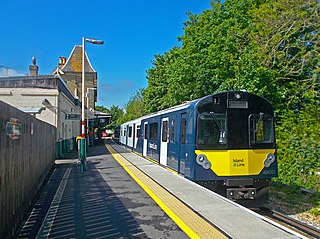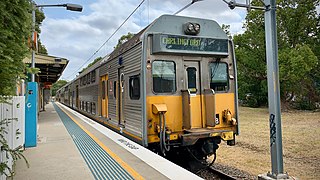Related Research Articles

The Island Line is a railway line on the Isle of Wight which runs along the island's east coast and links Ryde Pier Head with Shanklin. Trains connect at Ryde Pier Head with passenger ferries to Portsmouth Harbour, and these ferries in turn connect with the rest of the National Rail network via the Portsmouth Direct Line. The line also connects to the Isle of Wight Steam Railway, a heritage railway, at Smallbrook Junction. For much of its length the line runs alongside the A3055, criss-crossing this road by means of the Ryde Tunnel and bridges at Rowborough, Morton Common, Lake Hill and Littlestairs.

Central is a heritage-listed railway station located in the centre of Sydney, New South Wales, Australia. The station is the largest and busiest railway station in Australia and serves as a major transport interchange for NSW TrainLink inter-city rail services, Sydney Trains commuter rail services, Sydney light rail services, bus services, and private coach transport services. The station is also known as Sydney Terminal. The property was added to the New South Wales State Heritage Register on 2 April 1999. It recorded 85.4 million passenger movements in 2018 and serves over 250,000 people daily.

The Eastern Suburbs Railway (ESR) is a commuter railway line in Sydney constructed in the 1970s. It is operated by Sydney Trains and has stations at Martin Place, Kings Cross, Edgecliff and Bondi Junction. In addition, it has dedicated platforms at Town Hall, Central and Redfern stations. All of these stations are underground. The Eastern Suburbs railway connects with the Illawarra line at Erskineville, forming the Eastern Suburbs & Illawarra Line. The line features turnbacks at Central, Martin Place and Bondi Junction. There was also previously a rarely used cross-over at Edgecliff. It operates a service every 3 to 5 minutes during weekday peak hours and 8 to 10 minutes at all other times.

Dundas railway station, originally Kissing Point Road railway station, is a heritage-listed former railway station in Sydney, Australia, that was open between 1896 and 2020 and was located on the Carlingford line, serving the suburb of Dundas.

Rosehill railway station was a railway station in Sydney, Australia that was located next to Rosehill Gardens Racecourse. It was open between 1888 and 2020. It served passengers on the Sandown railway line until 1991, the Carlingford Line until 2020, and special event services to the racecourse, as well as serving the local suburb of Rosehill.

Camellia railway station, originally Subiaco railway station, was a railway station in Sydney, Australia, that was open between 1885 and 2020. It was located on the Carlingford line, serving the suburb of Camellia and at the time of closure was served by Sydney Trains T6 Carlingford line services.

Camellia is a suburb of Sydney, in the state of New South Wales, Australia. Primarily industrial with no residential population, environmental remediation commenced in late 2015, with the suburb ear-marked as a major centre for future high density living.

Sydney, the largest city in Australia, has an extensive network of passenger and freight railways. The passenger system includes an extensive suburban railway network, operated by Sydney Trains, a metro network and a light rail network. A dedicated freight network also exists. Future expansion of the light rail network includes the Parramatta Light Rail. Existing light rail services are the Inner West Light Rail and the CBD & South East Light Rail.

The Sandown Line is a short former industrial railway line in the western suburbs of Sydney, New South Wales, Australia. It began life as the Bennett's Railway, opening on 17 November 1888. The line diverges from the Carlingford line just south of Camellia station.

The Main Suburban railway line is the technical name for the trunk railway line between Redfern railway station and Parramatta railway station in Sydney, Australia, but now generally refers to the section between Redfern and where the Old Main South Line branches off at Granville Junction. The railway line then continues on as the Main Western line towards the Blue Mountains. This term distinguished this trunk line from the Illawarra Line which branched south from the Illawarra Junction to Wollongong, and later the North Shore tracks which carried trains north over the Harbour Bridge.

Island Line is a brand of the South Western Railway train operating company which runs the 8.5-mile (13.7 km) Island Line on the Isle of Wight. A stand-alone franchise from 1996 until 2007, it then became part of the South Western franchise operated by South West Trains until August 2017 and since by South Western Railway.

Sydney Trains is the operator and brand name of the train network serving the Greater Sydney metropolitan area in New South Wales, Australia. The network is a hybrid urban-suburban rail system with a central underground core that covers 369 km (229 mi) of route length over 813 km (505 mi) of track, with 170 stations on eight lines.

Wallangarra railway station is a heritage-listed railway station at Woodlawn Street, Wallangarra, Southern Downs Region, Queensland, Australia. It was built in 1877 along the state border of Queensland and New South Wales It was added to the Queensland Heritage Register on 28 March 2003.

The Carlingford railway line was a railway line in Sydney, New South Wales, Australia. It was opened from Clyde to Subiaco in January 1885, then by means of the construction of a bridge across the Parramatta River, to Carlingford in April 1896. It closed on 5 January 2020 with much of the line to be converted to light rail as part of the Parramatta Light Rail network, while a short section of the line was retained for use by Sydney Trains.

The Parramatta Light Rail is a 12-kilometre (7 mi) standard gauge light rail line currently under construction in Sydney, New South Wales, Australia.
Hardies Platform was a railway station on the Sandown railway line in the then-industrial suburb of Camellia in Sydney, Australia. It opened 4 April 1938 and served a nearby factory owned by James Hardie Industries. On 18 June 1959, the original platform was replaced by a new one located on the up track on the Sandown side of the Grand Avenue level crossing. Passenger services on the Sandown line, and hence to Hardies, ceased on 19 December 1991.

Sandown Platform was a railway station in the then-industrial suburb of Camellia in Sydney, Australia, which opened 24 October 1892. The station was situated on the Sandown railway line adjacent to the Parramatta River and was the location for a container terminal as well as a refinery tanker loading facility. It was the terminus for electric train services on the Sandown line which commenced 10 August 1959.
Goodyear Platform was a railway station on the Sandown railway line in the then-industrial suburb of Camellia in Sydney, Australia. It opened in January 1934 and served the Goodyear tyre factory in Camellia. The closure of Goodyear station preceded the closure of Hardies and Sandown.
Australian Kerosene Oil Company or 'A.K.O' mined and processed oil shale to produce kerosene, paraffin wax and candles, lubricating oil and greases, and other petroleum-based products, in New South Wales Australia. It is particularly associated with the site of its mine and works, at Joadja. At times, it also had other mining operations, at Airly and near Katoomba, and a soap and candle factory at Camellia. The company used the brand name 'Southern Cross' for its kerosene products.
References
- ↑ "Camellia". dictionaryofsydney.org. Archived from the original on 24 February 2011. Retrieved 3 April 2020.
- 1 2 "Cream Of Tartar Works Platform". www.nswrail.net. Retrieved 24 March 2020.
- ↑ "Parramatta's Industrial Heritage – The Australian Cream Tartar Company". Heritage Archives and Library Research and Collection Services. 3 June 2015. Archived from the original on 24 March 2020. Retrieved 24 March 2020.
- ↑ "Camellia" (PDF). Australia Railway Historical Society. Archived (PDF) from the original on 10 April 2019. Retrieved 24 March 2020.
- ↑ McClymont, John (June 2009). "Camellia". University of Technology Sydney. Archived from the original on 19 August 2014. Retrieved 2 April 2020.